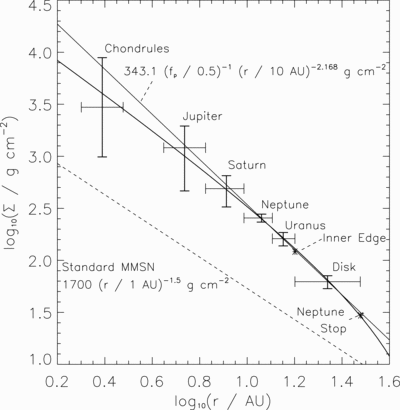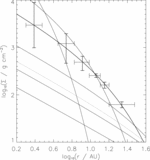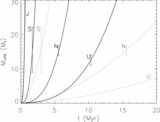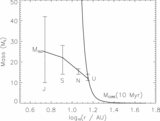Image Details

Caption: Fig. 1.
Distribution of mass in the solar nebula. Vertical bars reflect the theoretical uncertainties in the augmented masses of the planets. Vertical bars run through the presumed starting location of each planet. Horizontal bars span the assumed feeding zones of each planet and should not be interpreted as uncertainties. Horizontal bars run through the surface density corresponding to the presumed augmented mass of each object. The solid line depicts the least‐squares fit using the four giant planets and the planetesimal disk ("Disk") that lay beyond Uranus and Neptune. The derived fit, ﹩343( f_{p}/ 0.5) ^{-1}( r/ 10\ \mathrm{AU}\,) ^{-2.168}\ \mathrm{g}\,\ \mathrm{cm}\,^{-2}﹩ (graphed here assuming ﹩f_{p}=0.5﹩), differs significantly from the standard MMSN formula (eq. [1]), ﹩\Sigma ( r) =1700( r/ 1\ \mathrm{AU}\,) ^{-1.5}\ \mathrm{g}\,\ \mathrm{cm}\,^{-2}﹩. It is much larger (even if ﹩f_{p}=1﹩), and it alone is consistent with the surface density of gas in the chondrule‐forming region ("Chondrules"). Additional constraints from the timing of the LHB ("Inner Edge") and the location where Neptune stopped migrating ("Neptune Stop") are depicted. The thick line is our fit based on a photoevaporating decretion disk, described in § 3.
Copyright and Terms & Conditions
© 2007. The American Astronomical Society. All rights reserved. Printed in U.S.A.






